When Stephen Kurpinsky, bartender at George’s at the Cove in San Diego, was approached by his chef with a request to look into making milk punch, he was initially skeptical. “He’d had a couple in New York and he was just enthralled with the idea,” says Kurpinsky. “I thought he was referring to that New Orleans style milk punch with brandy and milk and a little bit of nutmeg. I was like: ‘Are you sure? That’s really not all that elevated.’ He said: ‘No, these are different. They were clarified.’”
“When he first told me a lot of these milk punches were clarified I was like: ‘That’s gotta be a modern technique’ and then we started researching it and it’s a historical technique,” says Kurpinsky. “I found that to be fascinating. When we think about clarified now, I think about Booker and Dax in New York with Dave Arnold doing centrifugal clarification with chemical components. I don’t think about somebody boiling milk and introducing it to acid.”
Clarified milk punch (often called English milk punch) is a very early classic cocktail, originally dating back to at least the 1600s. Like other punches, it was made in quantity. The clarification process made it very stable, and though it changes in character over time, it can be stored almost indefinitely without refrigeration.
Eamon Rockey, general manager at Betony, tried his first milk punch while beginning his bartending career at Eleven Madison Park. He became, in his words, obsessed. His research turned up Ben Franklin’s own recipe, which included generous amounts of brandy, sent in a letter to the first governor of Massachusetts, and Jerry Thomas’ recipe from the “Bartender’s Guide.” He read about Aphra Behn, the British playwright who waxed poetic about milk punch in her writing and was credited with its invention at the time. When he came to Betony six years ago, milk punch came with him.
 Milk punch is a staple of Eamon Rockey’s bar program at Betony in NYC — it’s a drink that’s been in his repertoire since the beginning of his career behind the stick. Photo courtesy of Betony.
Milk punch is a staple of Eamon Rockey’s bar program at Betony in NYC — it’s a drink that’s been in his repertoire since the beginning of his career behind the stick. Photo courtesy of Betony.
“Milk punch, in its most basic form, is warm milk that is broken with high acid citrus juice and then complemented by other flavors like fresh pineapple or earl grey tea, bourbon, brandy, gin or champagne,” says Rockey. “You need that base of milk that’s intended to be broken with fresh citrus juice and then whatever the heck else you want to throw in there. You clarify it all together and it comes out looking like water, or darn near water. It’s just a lot of fun.”
Although the classic version uses dairy milk, many bartenders are playing with different kinds of alternatives to dairy to see what they add to the drink. A local colleague of Kurpinsky’s is making milk punch in a Mexican restaurant with coconut milk. Kurpinsky is always ready to experiment with something new. “I haven’t used almond milk but I’m sure that would also work,” he says. “Anything that has that kind of fattiness in it that can break and then split the punch.” He’s a fan of using coconut milk although, like any ingredient substitution, it requires some tweaking to the rest of the recipe.
“Why it’s only now that bartenders are waking up and starting to make it I have no idea, but for sure it’s good that it’s back,” says Nico de Soto, co-owner of Mace in New York City and owner of Danico in Paris. “If I had to choose one drink forever it would be that.”
The clarification process can be tedious and time consuming. “It does take three days if you want to do it right,” says Kurpinsky. “By the second day you’re ready to produce something else. A lot of it is just who has that kind of time and devotion. It’s usually the kind of places that are cutting their own ice by hand, if you’re that committed then you probably could do this.”
While de Soto is thrilled to see milk punch popping up on more menus, he has noticed an occasional problem. “I go to many bars and I ask for the milk punch and they say ‘oh we don’t have it tonight,’” he says. “Because it takes two or three days to make it, if you run out and you’re not prepared, you’re screwed.”
Although historic milk punches were riffs on the same basic recipe, modern interpretations are all over the map with flavors and spirits. “Milk punch for me is like making soup,” says Rockey. “You can make tomato, chicken, lentil soup, anything you want. It’s the most versatile way of preparing something and that’s the way I think of milk punch. In the fall you can make beet milk punch using beet juice and goat’s milk instead of cow’s milk. In the summer you can make watermelon milk punch with fresh lime and maybe some basil. You can do herbal milk punches in the spring using whatever bright green flavors are popping out of the snow here in New York. It’s limitless.”
In another modern twist, Rockey usually clarifies his milk punches virgin, allowing the guest to choose spirits they like to complement the other flavors. There’s always a milk punch on the menu at Betony, but beyond that, there’s a secret milk punch as well just waiting for a deserving regular who might appreciate something special. Right now it’s lavender and honey and the juice of whole lemons.
Although Kurpinsky usually draws his inspiration from his geographic location, taking his cues from the local palate, he recently tried something completely different, creating a milk punch for an event using cereal milk from Fruit Loops. He and his chef crunched through a bowl and chose spices and flavors to complement the cereal, including coriander, fennel, hyssop and nutmeg, even if it did feel strange to be pairing Froot Loops with … well, anything. “The cool thing was is that it was subtle,” he says. “You didn’t get the high fructose flavor that you would if you actually chomped on Fruit Loops.”
 At Mace, milk punch is made with chicharron, fat-washed jalapeno infused mezcal and blanco tequila, turmeric, coconut water, corn milk, lime juice, cloudy apple juice and eight secret spices. Photo courtesy of Mace.
At Mace, milk punch is made with chicharron, fat-washed jalapeno infused mezcal and blanco tequila, turmeric, coconut water, corn milk, lime juice, cloudy apple juice and eight secret spices. Photo courtesy of Mace.
Right now, on de Soto’s menu, you can get a milk punch made with chicharron, fat-washed jalapeno infused mezcal and blanco tequila, turmeric, coconut water, corn milk, lime juice, cloudy apple juice and eight secret spices. A another recent version included rum, coconut milk, mango juice and basmati rice water, among other things. Ben Franklin wouldn’t recognize his favorite drink.
Although guests might need a little encouragement to order a milk punch for the first time, it’s usually smooth sailing from there. “Every time I put a milk punch on the menu it’s number one in sales,” says de Soto. “I’ve never had someone return the drink.”
Kurpinsky is passionate about making milk punch accessible both for guests and those in the industry since, unlike most other classic cocktails, it’s not something you can whip up on the spur of the moment. “I want people to try it because I had never had one, and I’m so into cocktails and I’ve been in this industry for so long,” he says. “Let’s just get this out into people’s hands so they can try it.”
If you’re going to put a milk punch on your menu, Rockey recommends being sure you’re ready. “I hate it when bartenders put it on their menu trying to be cool and trying to follow the trend and it’s not executed properly,” he says. “There’s a learning curve there for sure, nobody’s expecting perfection right away, but if you’re going to put something on your menu and represent it that it’s going to be a classic cocktail, or a riff on one, then it has to be accurate.”
Try Stephen Kurpinsky’s “Follow Your Nose,” a clarified milk punch with a nostalgic twist





